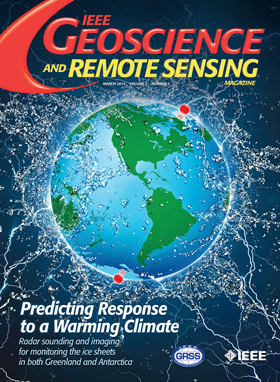基于压缩传感和机器学习的稀疏合成孔径雷达成像:理论、应用和趋势
IF 16.2
1区 地球科学
Q1 GEOCHEMISTRY & GEOPHYSICS
引用次数: 43
摘要
合成孔径雷达(SAR)成像可以看作是一类不适定线性逆问题,传统匹配滤波器成像技术的分辨率受到数据带宽的限制。使用压缩传感(CS)的稀疏SAR成像技术已被开发用于增强性能,如超分辨率、特征增强等。最近,包括深度学习(DL)在内的机器学习(ML)稀疏SAR成像得到了进一步研究,在成像领域显示出巨大潜力。然而,这两组稀疏SAR成像方法之间仍然存在差距,它们之间的联系尚未建立。本文章由计算机程序翻译,如有差异,请以英文原文为准。
Sparse Synthetic Aperture Radar Imaging From Compressed Sensing and Machine Learning: Theories, applications, and trends
Synthetic aperture radar (SAR) image formation can be treated as a class of ill-posed linear inverse problems, and the resolution is limited by the data bandwidth for traditional imaging techniques via matched filter (MF). The sparse SAR imaging technology using compressed sensing (CS) has been developed for enhanced performance, such as superresolution, feature enhancement, etc. More recently, sparse SAR imaging from machine learning (ML), including deep learning (DL), has been further studied, showing great potential in the imaging area. However, there are still gaps between the two groups of methods for sparse SAR imaging, and their connections have not been established.
求助全文
通过发布文献求助,成功后即可免费获取论文全文。
去求助
来源期刊

IEEE Geoscience and Remote Sensing Magazine
Computer Science-General Computer Science
CiteScore
20.50
自引率
2.70%
发文量
58
期刊介绍:
The IEEE Geoscience and Remote Sensing Magazine (GRSM) serves as an informative platform, keeping readers abreast of activities within the IEEE GRS Society, its technical committees, and chapters. In addition to updating readers on society-related news, GRSM plays a crucial role in educating and informing its audience through various channels. These include:Technical Papers,International Remote Sensing Activities,Contributions on Education Activities,Industrial and University Profiles,Conference News,Book Reviews,Calendar of Important Events.
 求助内容:
求助内容: 应助结果提醒方式:
应助结果提醒方式:


